Statistical Analysis of the Spatiotemporal Distribution of Ozone Induced by Cut-Off Lows in the Upper Troposphere and Lower Stratosphere over Northeast Asia
Abstract
1. Introduction
2. Data and Methodology
2.1. Ozone and Meteorology Data
2.2. Methodology for Identifying Cut-Off Lows
2.3. Statistical Analysis of Cut-Off-Lows in Northeast Asia
2.4. The COLs Coordinates
2.4.1. The COLs Coordinate of ERA-Interim Dataset
2.4.2. The COLs Coordinate of the AIRS Dataset
3. Statistical Analysis of the Ozone Characteristics of COLs
3.1. Ozone Spatial Distribution Revealed by the ERA-Interim Dataset
3.2. Temporal Variations Revealed by the ERA-Interim Dataset
3.3. Temporal and Spatial Distributions Revealed by the AIRS Dataset
4. Summary and Discussion
Author Contributions
Funding
Acknowledgments
Conflicts of Interest
Appendix A. Statistical Synthesis Analysis of ERA-Interim Data
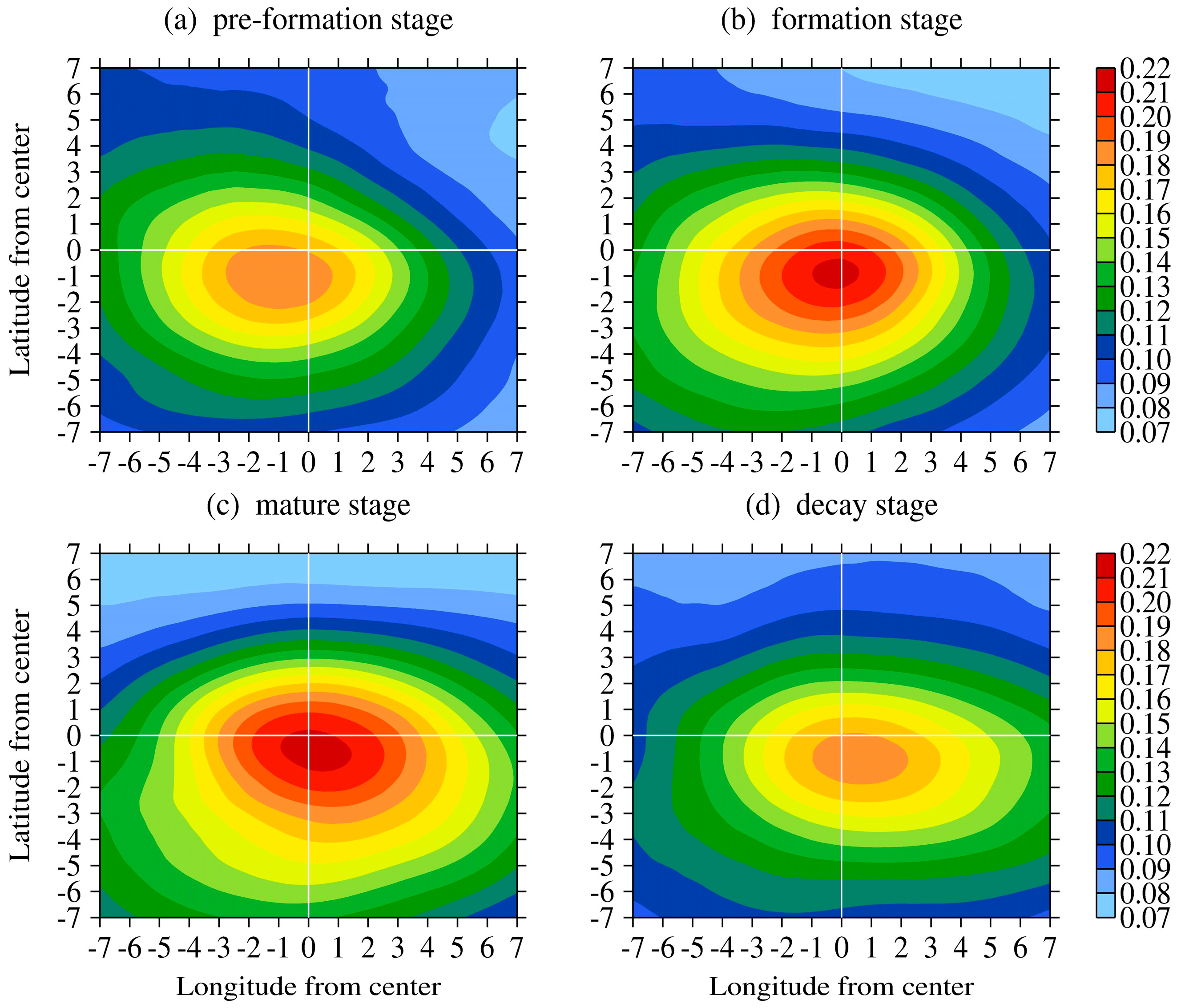
Appendix B. Statistical Analysis of AIRS Ozone Data
References
- Kremser, S.; Thomason, L.W.; von Hobe, M.; Hermann, M.; Deshler, T.; Timmreck, C.; Toohey, M.; Stenke, A.; Schwarz, J.P.; Weigel, R.; et al. Stratospheric aerosol—Observations, processes, and impact on climate. Rev. Geophys. 2016, 54, 278–335. [Google Scholar] [CrossRef]
- Solomon, S.; Rosenlof, K.H.; Portmann, R.W.; Daniel, J.S.; Davis, S.M.; Sanford, T.J.; Plattner, G.K. Contributions of stratospheric water vapor to decadal changes in the rate of global warming. Science 2010, 327, 1219–1223. [Google Scholar] [CrossRef] [PubMed]
- Yu, P.; Toon, O.B.; Bardeen, C.G. Black carbon lofts wildfire smoke high into the stratosphere to form a persistent plume. Science 2019, 365, 587–590. [Google Scholar] [CrossRef] [PubMed]
- Holton, J.R.; Haynes, P.H.; McIntyre, M.E.; Douglass, A.R.; Rood, R.B.; Pfister, L. Stratosphere-troposphere exchange. Rev. Geophys. 1995, 33, 403–439. [Google Scholar] [CrossRef]
- Stohl, A.; Wernli, H.; James, P.; Bourqui, M.; Forster, C.; Liniger, M.A.; Seibert, P.; Sprenger, M. A new perspective of stratosphere-troposphere exchange. Bull. Am. Meteorol. Soc. 2003, 84, 1565–1573. [Google Scholar] [CrossRef]
- Gettelman, A.; Hoor, P.; Pan, L.L.; Randel, W.J.; Hegglin, M.I.; Birner, T. The extratropical upper troposphere and lower stratosphere. Rev. Geophys. 2011, 49, RG3003. [Google Scholar] [CrossRef]
- Stohl, A.; Bonasoni, P.; Cristofanelli, P.; Collins, W.; Feichter, J.; Frank, A.; Forster, C.; Gerasopoulos, E.; Gäggeler, H.; James, P.; et al. Stratosphere-troposphere exchange: A review, and what we have learned from STACCATO. J. Geophys. Res. 2003, 108. [Google Scholar] [CrossRef]
- Pan, L.L.; Bowman, K.P.; Shapiro, M.; Randel, W.J.; Gao, R.S.; Canpos, T.; Davis, C.; Schauffler, S.; Ridley, B.A.; Wei, J.C.; et al. Chemical behavior of the tropopause observed during the Stratosphere-Troposphere Analyses of Regional Transport experiment. J. Geophys. Res. 2007, 112. [Google Scholar] [CrossRef]
- Pan, L.L.; Bowman, K.P.; Atlas, E.L.; Wofsy, S.C.; Zhang, F.; Bresch, J.F.; Ridley, B.A.; Pittman, J.V.; Homeyer, C.R.; Romashkin, P.; et al. The stratosphere-troposphere analyses of regional transport 2008 experiment. Bull. Am. Meteorol. Soc. 2010, 91, 327–342. [Google Scholar] [CrossRef]
- Guo, D.; Su, Y.C.; Zhou, X.J.; Xu, J.J.; Shi, C.H.; Liu, Y.; Li, W.L.; Li, Z.K. Evaluation of the trend uncertainty in summer ozone valley over the Tibetan Plateau in three reanalysis datasets. J. Meteorol. Res. 2017, 31, 431–437. [Google Scholar] [CrossRef]
- Guo, D.; Su, Y.C.; Shi, C.H.; Xu, J.J.; Powell, A.M. Double core of ozone valley over the Tibetan Plateau and its possible mechanisms. J. Atmos. Sol-Terr Phys. 2015, 130, 127–131. [Google Scholar] [CrossRef]
- Price, J.D.; Vaughan, G. The potential for stratosphere-troposphere exchange in cut-off-low systems. Q. J. R. Meteorol. Soc. 1993, 119, 343–365. [Google Scholar] [CrossRef]
- Shi, C.H.; Zhang, C.X.; Guo, D. Comparison of electrochemical concentration cell ozonesonde and microwave limb sounder satellite remote sensing ozone profiles for the center of the South Asian High. Remote Sens. 2017, 9, 1012. [Google Scholar] [CrossRef]
- Homeyer, C.R.; Bowman, K.P.; Pan, L.L.; Atlas, E.L.; Gao, R.S.; Campos, T.L. Dynamical and chemical characteristics of tropospheric intrusions observed during START08. J. Geophys. Res. 2011, 116, D06111. [Google Scholar] [CrossRef]
- Chen, D.; Chen, Z.Y.; Lü, D.R. Simulation of the generation of stratospheric gravity waves in upper-tropospheric jet stream accompanied with a cold vortex over Northeast China. Chin. J. Geophys. 2014, 57, 10–20. (In Chinese) [Google Scholar]
- Nieto, R.; Gimeno, L.; Torre, L.D.L.; Ribera, P.; Gallego, D.; García, J.A.; Nunez, M.; Redano, A.; Lorente, J. Climatological features of cutoff low systems in the Northern Hemisphere. J. Clim. 2005, 18, 3085–3103. [Google Scholar] [CrossRef]
- Zhang, C.; Zhang, Q.; Wang, Y.; Liang, X. Climatology of warm season cold vortices in East Asia: 1979–2005. Meteorol. Atmos. Phys. 2008, 100, 291–301. [Google Scholar] [CrossRef]
- Hu, K.X.; Lu, R.Y.; Wang, D.H. Seasonal climatology of cut-off lows and associated precipitation patterns over Northeast China. Meteorol. Atmos. Phys. 2010, 106, 37–48. [Google Scholar] [CrossRef]
- Gimeno, L.; Trigo, R.M.; Ribera, P.; García, J.A. Editorial: Special issue on cut-off-low systems (COL). Meteorol. Atmos. Phys. 2007, 96, 1–2. [Google Scholar] [CrossRef]
- Matsumoto, S.; Ninomiya, K.; Hasegawa, R.; Miki, Y. The structure and the role of a subsynoptic-scale cold vortex on heavy precipitation. J. Meteorol. Soc. Jpn. 1982, 60, 339–354. [Google Scholar] [CrossRef]
- Ancellet, G.; Beekmann, M.; Papayiannis, A. Impact of a cutoff development on downward transport of ozone in the troposphere. J. Geophys. Res. 1994, 99, 3451–3463. [Google Scholar] [CrossRef]
- Langford, A.O.; Masters, C.D.; Proffitt, M.H.; Hsie, E.Y.; Tuck, A.F. Ozone measurements in a tropopause fold associated with a cut-off low system. Geophys. Res. Lett. 1996, 23, 2501–2504. [Google Scholar] [CrossRef]
- Mohanakumar, K. Stratosphere Troposphere Interactions: An Introduction; Springer: Berlin, Germany, 2008; pp. 310–311. [Google Scholar]
- Yates, E.L.; Iraci, L.T.; Roby, M.C.; Pierce, R.B.; Johnson, M.S.; Reddy, P.J.; Tadić, J.M.; Loewenstein, M.; Gore, W. Airborne observations and modeling of springtime stratosphere-to-troposphere transport over California. Atmos. Chem. Phys. 2013, 13, 12481–12494. [Google Scholar] [CrossRef]
- Kuang, S.; Newchurch, M.J.; Burris, J.; Wang, L.H.; Knupp, K.; Huang, G.Y. Stratosphere-to-troposphere transport revealed by ground-based lidar and ozonesonde at a midlatitude site. J. Geophys. Res. 2012, 117, D18305. [Google Scholar] [CrossRef]
- Langford, A.O.; Brioude, J.; Cooper, O.R.; Senff, C.J.; Alvarez II, R.J.; Hardesty, R.M.; Johnson, B.J.; Oltmans, S.J. Stratospheric influence on surface ozone in the Los Angeles area during late spring and early summer of 2010. J. Geophys. Res. 2012, 117, D00V06. [Google Scholar] [CrossRef]
- Dempsey, F. Observations of stratospheric O-3 intrusions in air quality monitoring data in Ontario, Canada. Atmos. Environ. 2014, 98, 111–122. [Google Scholar] [CrossRef]
- Škerlak, B.; Sprenger, M.; Pfahl, S.; Tyrlis, E.; Wernli, H. Tropopause folds in ERA-Interim: Global climatology and relation to extreme weather events. J. Geophys. Res. 2015, 120, 4860–4877. [Google Scholar] [CrossRef]
- Vogel, B.; Pan, L.L.; Konopka, P.; Günther, G.; Müller, R.; Hall, W.; Campos, T.; Pollack, I.; Weinheimer, A.; Wei, J.K.; et al. Transport pathways and signatures of mixing in the extratropical tropopause region derived from Lagrangian model simulations. J. Geophys. Res. 2011, 116. [Google Scholar] [CrossRef]
- Škerlak, B.; Sprenger, M.; Wernli, H. A global climatology of stratosphere-troposphere exchange using the ERA-Interim data set from 1979 to 2011. Atmos. Chem. Phys. 2014, 14, 913–937. [Google Scholar] [CrossRef]
- Bian, J.; Gettelman, A.; Chen, H.; Pan, L.L. Validation of satellite ozone profile retrievals using Beijing ozonesonde data. J. Geophys. Res. 2007, 112. [Google Scholar] [CrossRef]
- Song, Y.; Lü, D.; Li, Q.; Bian, J.; Wu, X.; Li, D. The impact of cut-off lows on ozone in the upper troposphere and lower stratosphere over Changchun from ozonesonde observations. Adv. Atmos. Sci. 2016, 33, 135–150. [Google Scholar] [CrossRef]
- Liu, C.; Liu, Y.; Liu, X.; Chance, K. Dynamical and chemical features of a cutoff low over northeast China in July 2007: Results from satellite measurements and reanalysis. Adv. Atmos. Sci. 2013, 30, 525–540. [Google Scholar] [CrossRef]
- Shi, C.; Li, H.; Zheng, B.; Guo, D.; Liu, R. Stratosphere-troposphere exchange corresponding to a deep convection in warm sector and abnormal subtropical front induced by a cutoff low over East Asia. Chin. J. Geophys. 2014, 57, 1–10. [Google Scholar]
- Chen, D.; Lü, D.R.; Chen, Z.Y. Simulation of the stratosphere-troposphere exchange process in a typical cold vortex over Northeast China. Sci. China Earth Sci. 2014, 57, 1452–1463. [Google Scholar] [CrossRef]
- Li, D.; Bian, J.C.; Fan, Q.J. A deep stratospheric intrusion associated with an intense cut-off low event over East Asia. Sci. China Earth Sci. 2015, 58, 116–128. [Google Scholar] [CrossRef]
- Yang, J.; Lü, D.R. A simulation study of stratosphere-troposphere exchange due to cut-off-low over eastern Asia. J. Appl. Meteor. Sci. 2003, 27, 1031–1044. (In Chinese) [Google Scholar]
- Parkinson, C.L. Aqua: An earth-observing satellite mission to examine water and other climate variables. IEEE Trans. Geosci. Remote 2003, 41, 173–183. [Google Scholar] [CrossRef]
- Monahan, K.P.; Pan, L.L.; McDonald, A.J.; Bodeker, G.E.; Wei, J.; George, S.E.; Barnet, G.D.; Maddy, E. Validation of AIRS v4 ozone profiles in the UTLS using ozonesondes from Lauder, NZ and Boulder, USA. J. Geophys. Res. 2007, 112. [Google Scholar] [CrossRef]
- Kentarchos, A.S.; Davies, T.D. A climatology of cut-off lows at 200 hPa in the Northern Hemisphere, 1990–1994. Int. J. Climatol. 1998, 18, 379–390. [Google Scholar] [CrossRef]
- Nieto, R.; Sprenger, M.; Wernli, H.; Trigo, R.M.; Gimeno, L. Identification and Climatology of Cut-off Lows near the Tropopause. Ann. N. Y. Acad. Sci. 2008, 1146, 256–290. [Google Scholar] [CrossRef] [PubMed]
- Campetella, C.M.; Possia, N.E. Upper-level cut-off lows in southern South America. Meteorol. Atmos. Phys. 2007, 96, 181–191. [Google Scholar] [CrossRef]
- Wen, D.; Li, Y.; Zhang, D.L.; Xue, L.; Wei, N. A statistical analysis of tropical upper-tropospheric trough cells over the western north Pacific during 2006-2015. J. Appl. Meteorol. Clim. 2018, 57, 2469–2483. [Google Scholar] [CrossRef]
- Cao, F.; Gao, T.; Li, D.; Ma, Z.; Yang, X.; Yang, F. Contribution of large-scale circulation anomalies to variability of summer precipitation extremes in northeast China. Atmos. Sci. Lett. 2018, 19, e867. [Google Scholar] [CrossRef]
- Hoskins, B.J.; McIntyre, M.E.; Robertson, A.W. On the use and significance of isentropic potential vorticity maps. Q. J. R. Meteorol. Soc. 1985, 111, 877–946. [Google Scholar] [CrossRef]
- World Meteorological Organization (WMO). Atmospheric Ozone 1985: WMO Global Ozone Research and Monitoring Project Report; WMO 16; World Meteorological Organization (WMO): Geneva, Switzerland, 1986. [Google Scholar]
- Hoinka, K.P. Statistics of the global tropopause pressure. Mon. Weather Rev. 1998, 126, 3303–3325. [Google Scholar] [CrossRef]
- McPeters, R.D.; Labow, G.J.; Logan, J.A. Ozone climatological profiles for satellite retrieval algorithms. J. Geophys. Res. 2007, 112. [Google Scholar] [CrossRef]
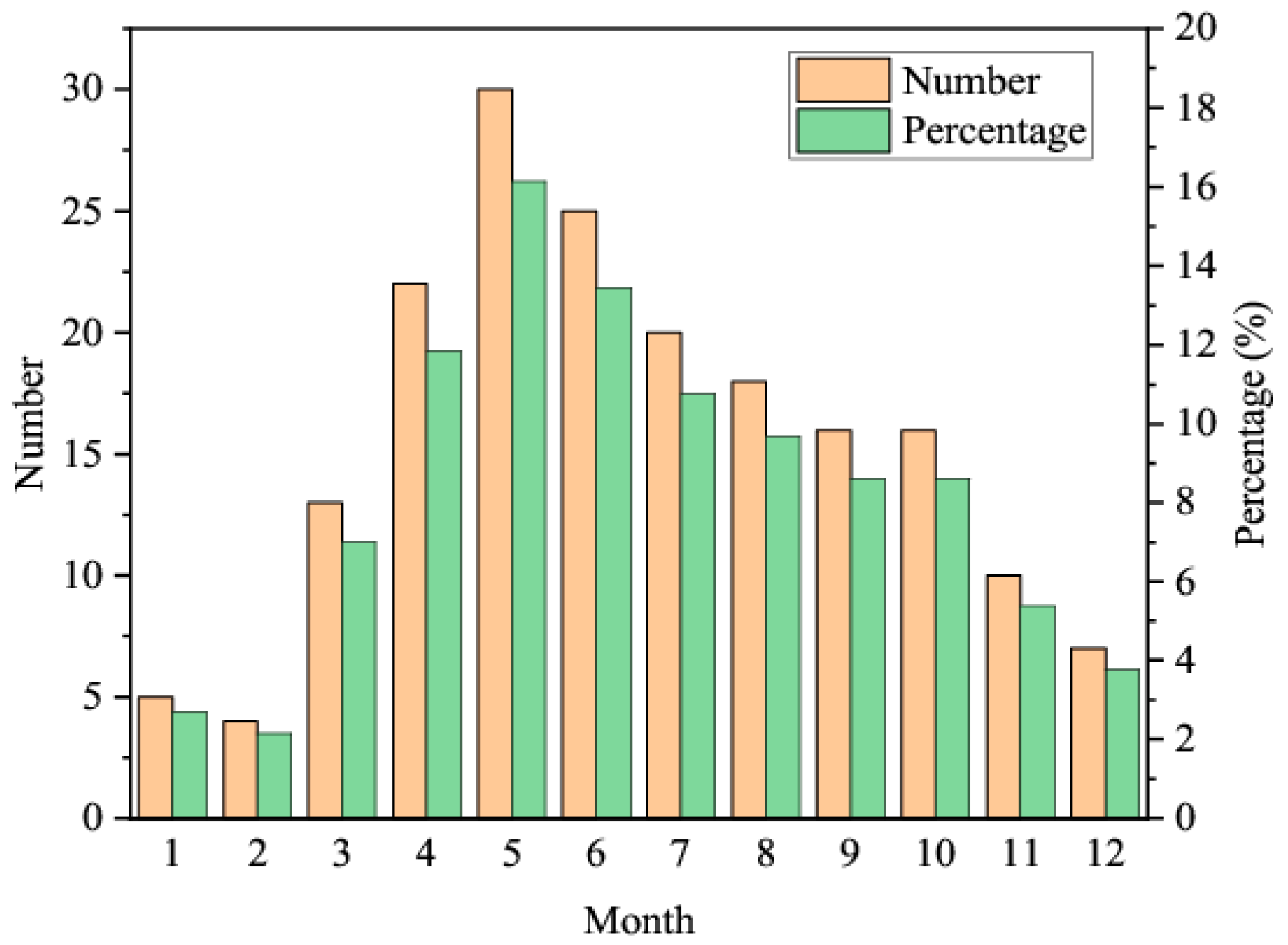
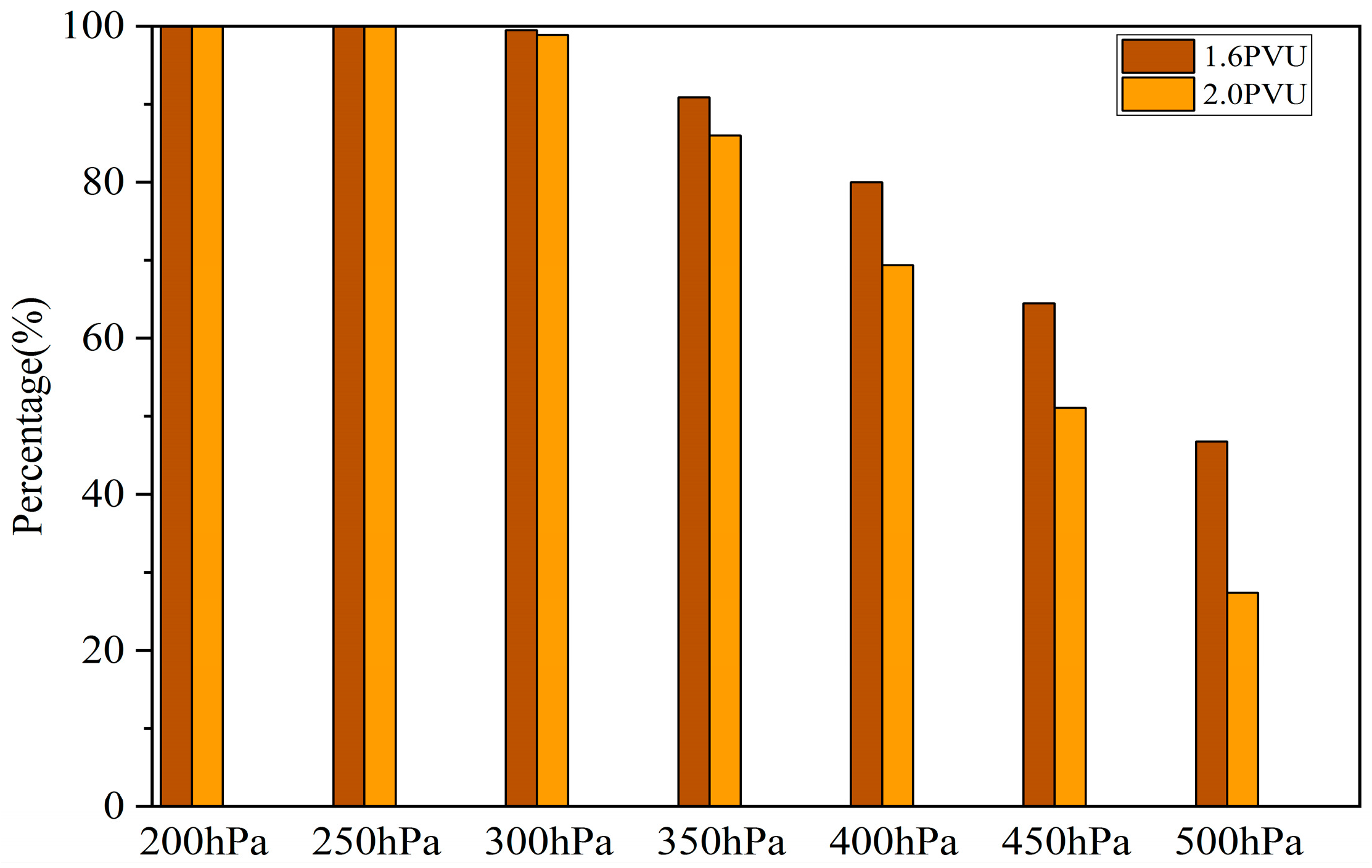
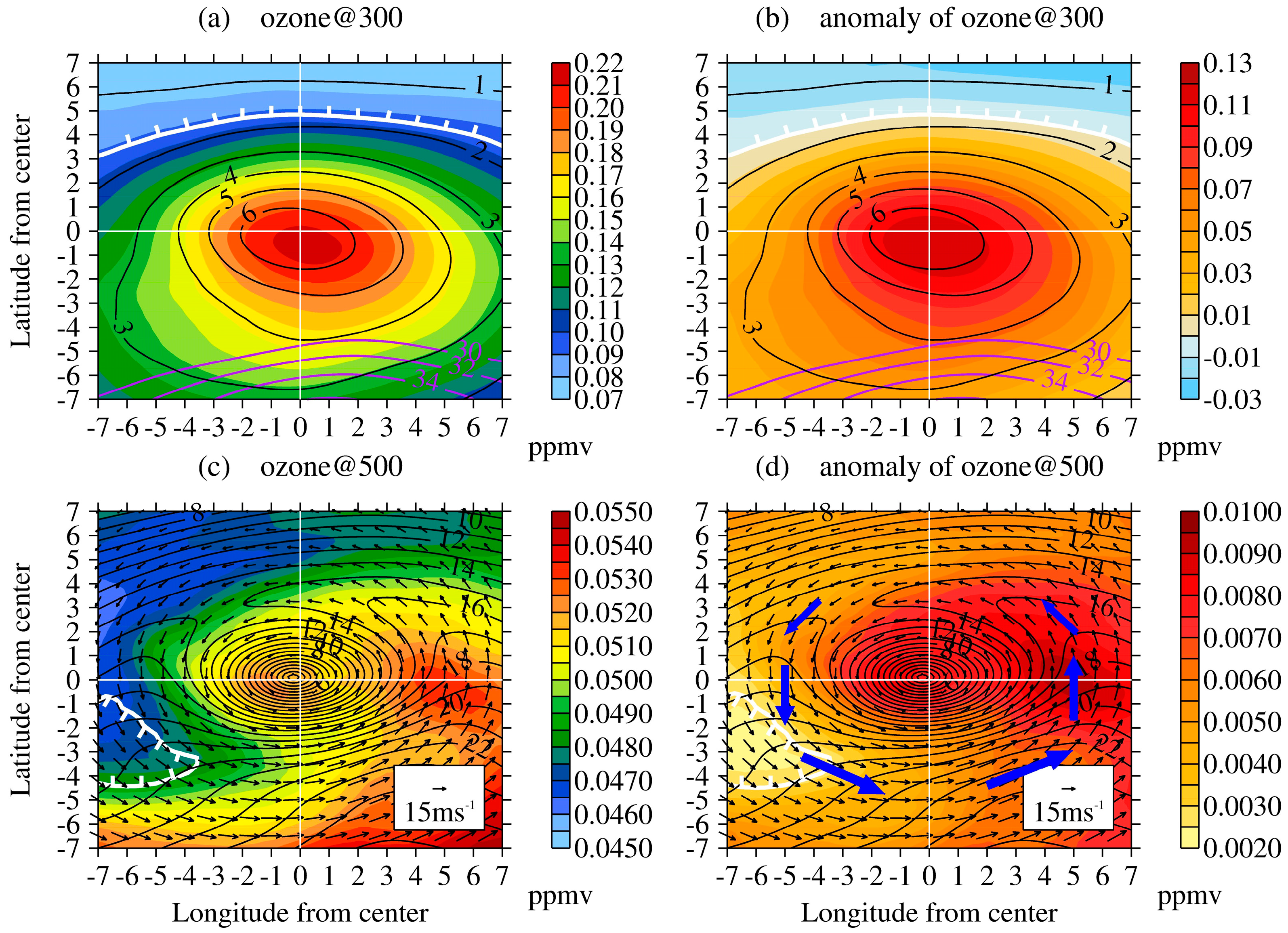
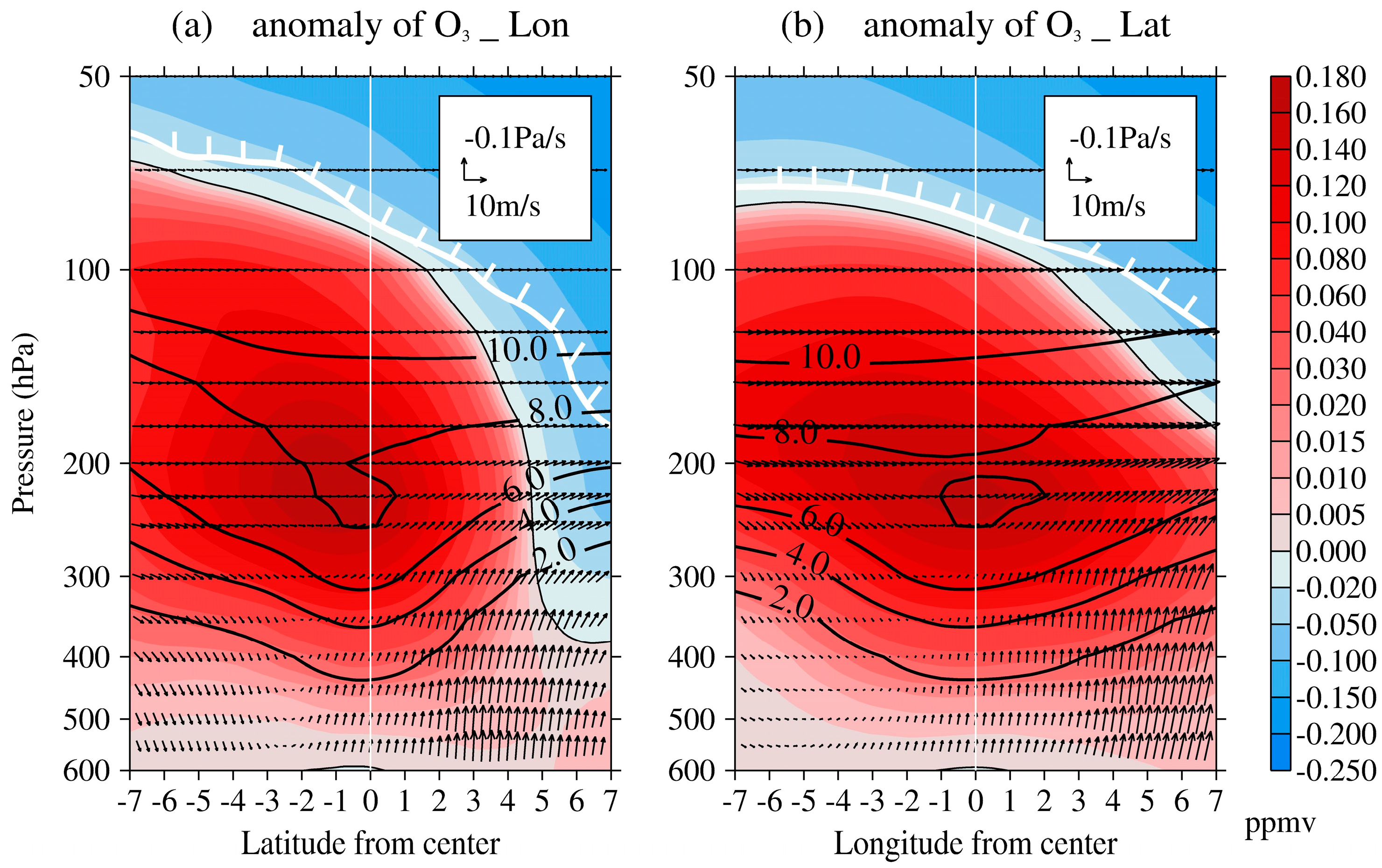
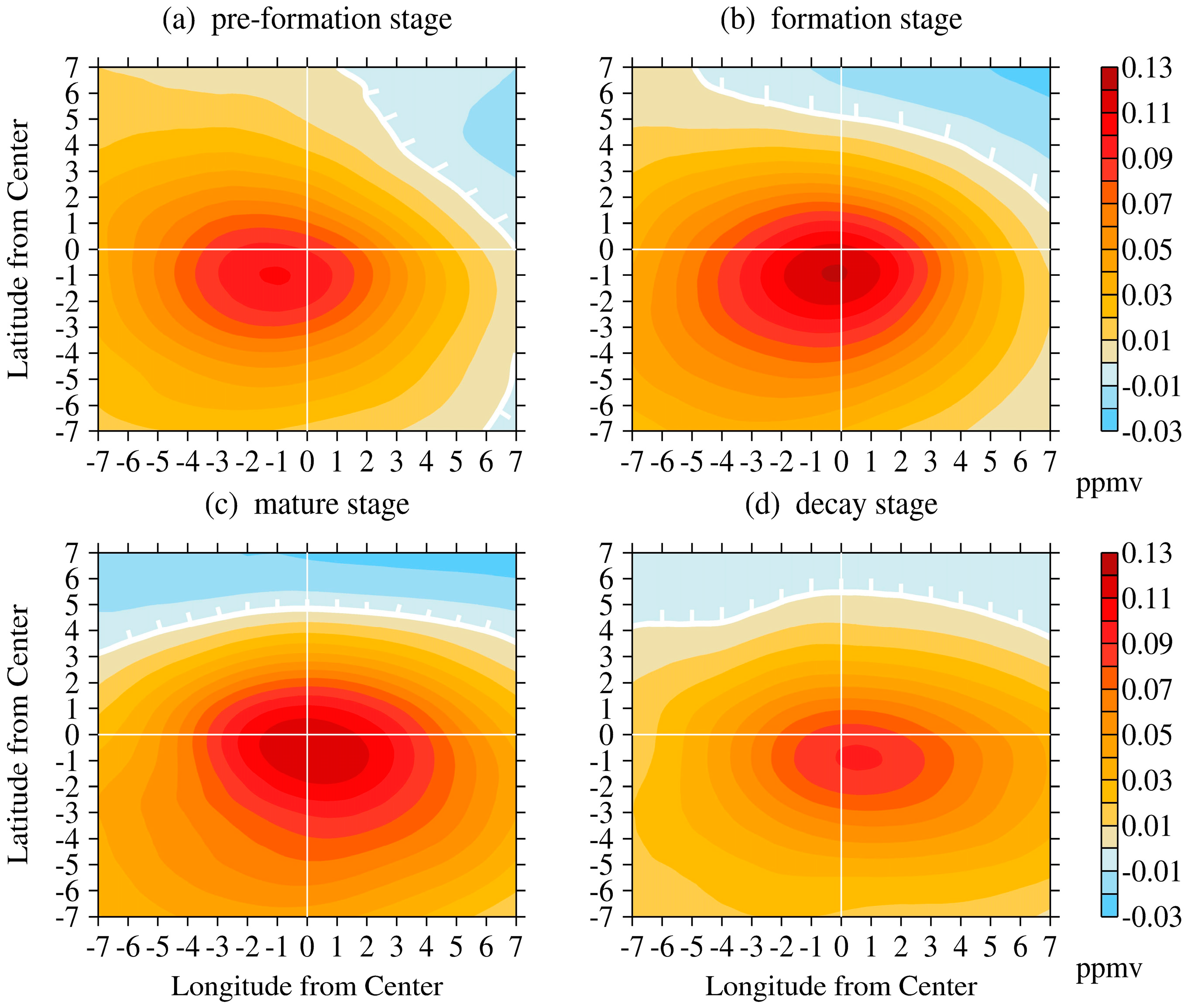
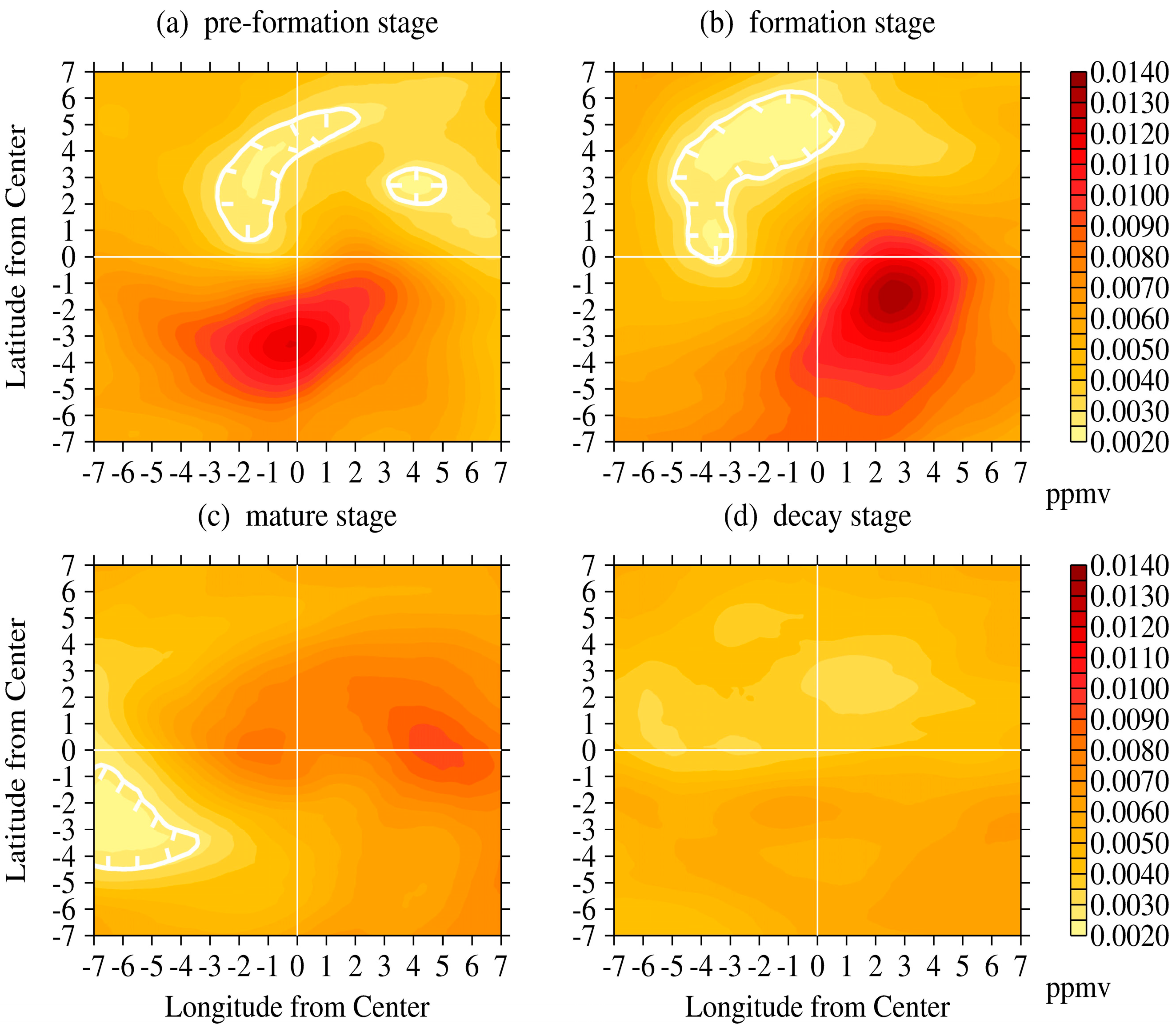
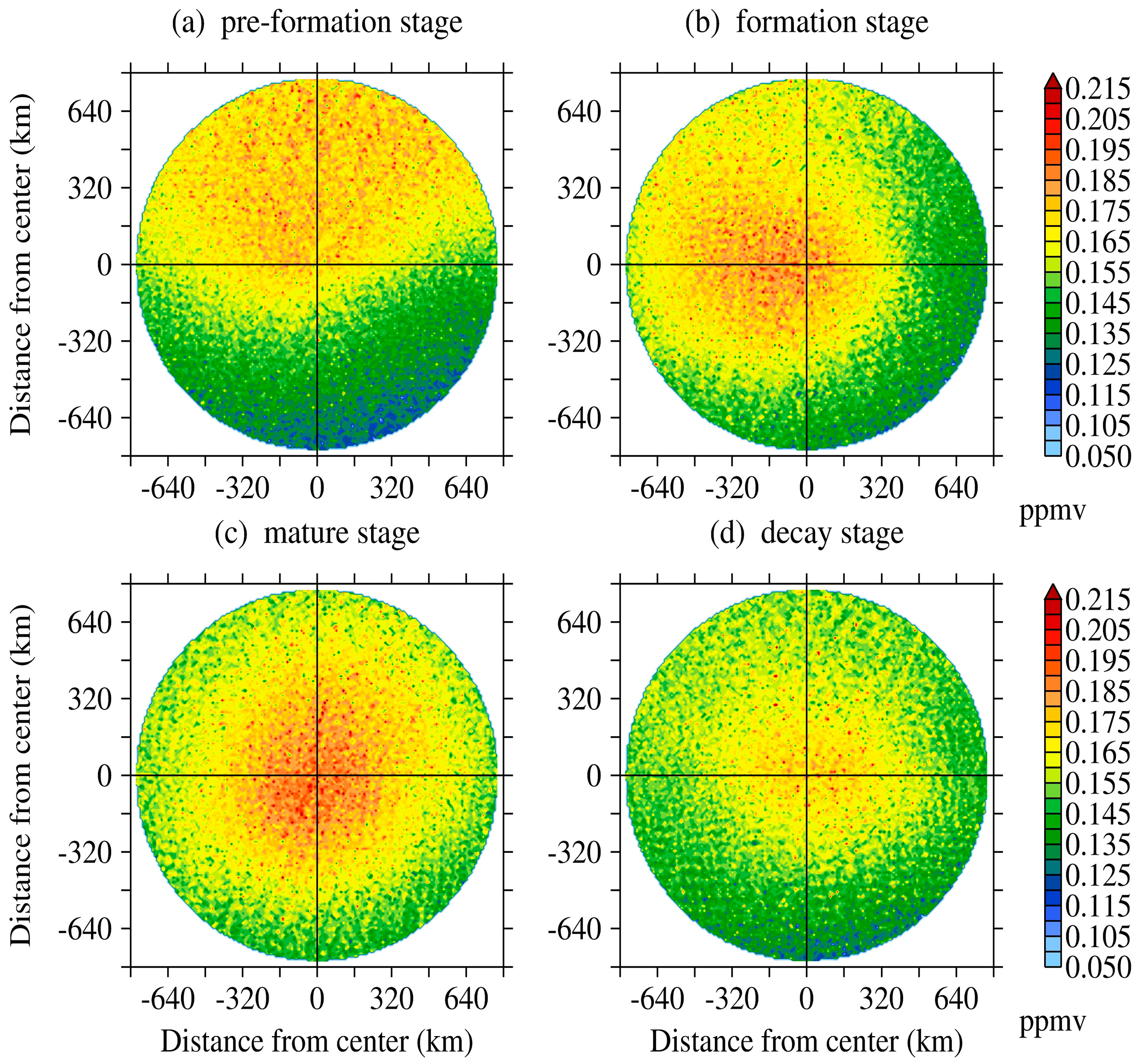
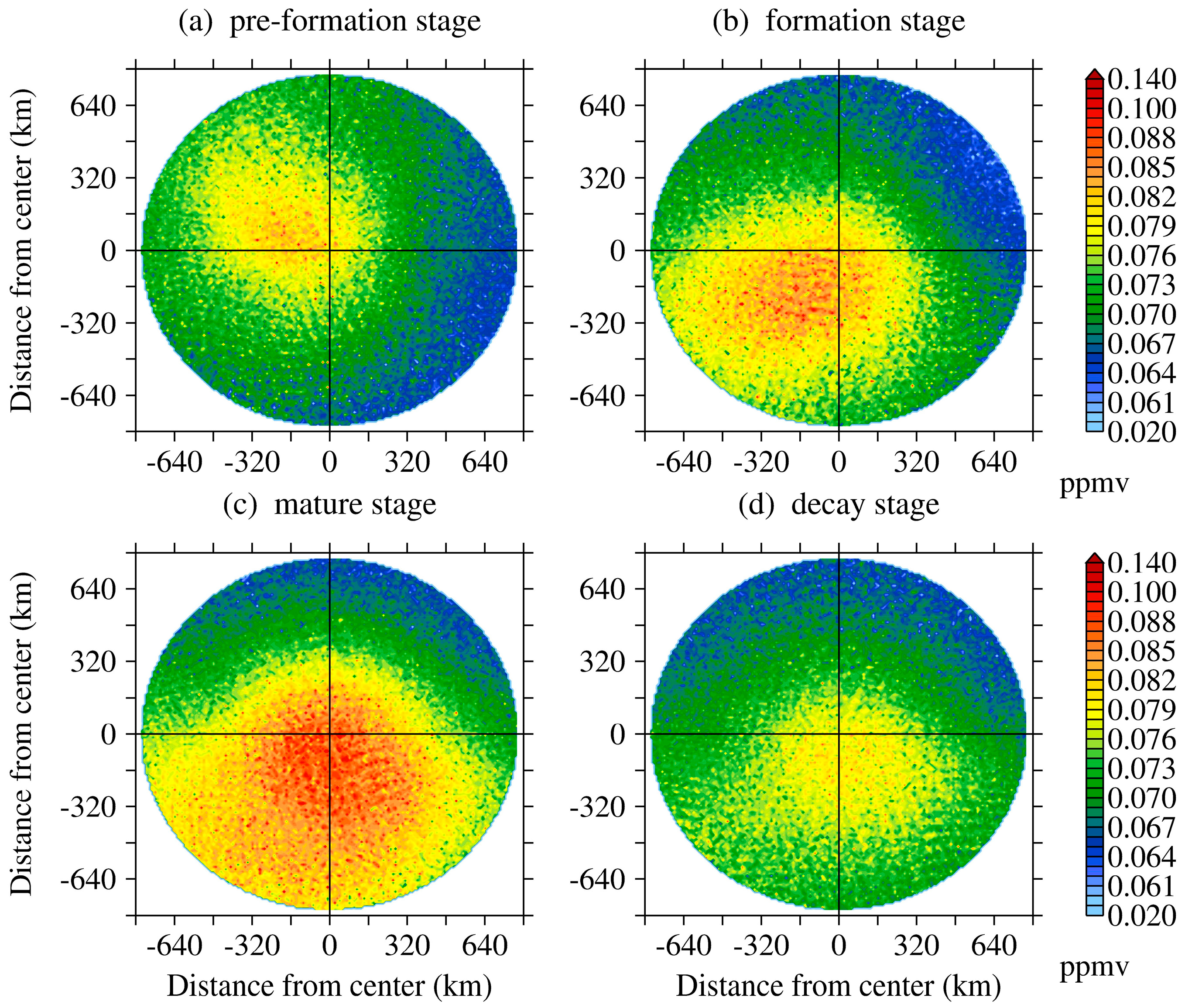
© 2019 by the authors. Licensee MDPI, Basel, Switzerland. This article is an open access article distributed under the terms and conditions of the Creative Commons Attribution (CC BY) license (http://creativecommons.org/licenses/by/4.0/).
Share and Cite
Chen, D.; Zhou, T.-J.; Ma, L.-Y.; Shi, C.-H.; Guo, D.; Chen, L. Statistical Analysis of the Spatiotemporal Distribution of Ozone Induced by Cut-Off Lows in the Upper Troposphere and Lower Stratosphere over Northeast Asia. Atmosphere 2019, 10, 696. https://doi.org/10.3390/atmos10110696
Chen D, Zhou T-J, Ma L-Y, Shi C-H, Guo D, Chen L. Statistical Analysis of the Spatiotemporal Distribution of Ozone Induced by Cut-Off Lows in the Upper Troposphere and Lower Stratosphere over Northeast Asia. Atmosphere. 2019; 10(11):696. https://doi.org/10.3390/atmos10110696
Chicago/Turabian StyleChen, Dan, Tian-Jiao Zhou, Li-Yun Ma, Chun-Hua Shi, Dong Guo, and Li Chen. 2019. "Statistical Analysis of the Spatiotemporal Distribution of Ozone Induced by Cut-Off Lows in the Upper Troposphere and Lower Stratosphere over Northeast Asia" Atmosphere 10, no. 11: 696. https://doi.org/10.3390/atmos10110696
APA StyleChen, D., Zhou, T.-J., Ma, L.-Y., Shi, C.-H., Guo, D., & Chen, L. (2019). Statistical Analysis of the Spatiotemporal Distribution of Ozone Induced by Cut-Off Lows in the Upper Troposphere and Lower Stratosphere over Northeast Asia. Atmosphere, 10(11), 696. https://doi.org/10.3390/atmos10110696





